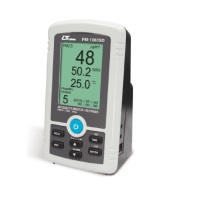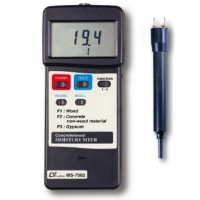Product Description
AIR QUALITY MONITOR/RECORDER
Model : PM-1064SD (PM2.5, CO2, %RH, Temp., Barometer)
Model : PM-1063SD (PM2.5, %RH, Temp.)
* Monitoring air pollutant source from dust, petrochemical industry, steel-making plant, thermal power plant, restaurant, smoke, burning plants, driving automobiles.
* The meter is a real-time air quality monitor instrument used to monitor the concentration of PM2.5, humidity and temperature in the indoor environment.
* PM2.5 : 0 to 250 g/m3
* Humidity : 5 to 95 %RH.
* Temperature : 0 to 50 oC, oC/oF.
* CO2 : 0 to 4,000 ppm, max. 6000ppm. (PM-1064SD only)
* Barometer : 10 to 1100 hPa, mmHg, inHg. (PM-1064SD only)
* PM2.5 time weighted average reading.
* Data hold,Record ( Max, Min ).
* Alarm setting with the beeper sound output.
* Health index ( 0 – 9 ) detection and alarm.
* Built-in clock and Calendar, real time data record with SD memory card, sampling time can be set from 2 to 3600 seconds. Just slot the SD card into the computer, all the measured values with the time information (year, month, data, hour, minute, second) can be downloaded to the Excel Directly, then user can make the further data analysis by themselves.
* Manual data record is available, can set the different position(location) No.( 1 to 99 ).
* SD card capacity : 1 GB to 32 GB.
* Dot matrix LCD display.
* Power by UM3/AA ( 1.5V ) x 6 batteries or DC 9V adapter.
* RS232/USB PC computer interface.
What is PM?
PM is short for “particulate matter”. It refers to particles found in the air, including dust, dirt, soot, smoke, and liquid droplets. Particles can be suspended in the air for long periods of time. Many man-made and natural sources emit PM directly or emit other pollutants that react in the atmosphere to form PM. These solid and liquid particles come in a wide range of sizes. Some particles are large or dark enough to be seen – like soot or smoke. Others are so small that individually, they can only be detected with an electron microscope.
What is the difference between PM2.5 and PM10?
PM is usually measured in two size ranges: PM10 and PM2.5.
PM10 refers to particles with diameters that are less than or equal to 10 microns in size (a micron, or micrometer, is one-millionth of a meter), or about 1/7 the diameter of a human hair.
PM2.5, also called “fine particulates,” consists of particles with diameters that are less than or equal to 2.5 microns in size. That’s about 1/30 the diameter of a human hair. PM2.5 is a more serious health concern than PM10, since smaller particles can travel more deeply into our lungs and affect your health.
Where does PM2.5 come from?
Fine particles are produced from all types of combustion, including motor vehicles, power plants, residential wood burning, forest fires, agricultural burning, volcanic eruptions, dust storms and some industrial processes. Some are emitted directly into the air, while others are formed when gases and particles interact with one another in the atmosphere.
Why is it so dangerous?
The health effects of PM10 and PM2.5 are well documented. Over-exposure to PM increases the risk of heart and lung illnesses and can reduce an individual’s lifespan. Alarmingly, there is no evidence of a safe level of exposure or a threshold below which no adverse health effects occur.
Numerous studies have linked long-term particle pollution, especially PM2.5, with significant health problems including:
- Increased respiratory symptoms, e.g. irritation of the airways, coughing or difficulty breathing
- Decreased lung function
- Aggravated asthma
- Development of chronic respiratory disease in children
- Development of chronic bronchitis or chronic obstructive lung disease
- Irregular heartbeat
- Nonfatal heart attacks
Premature death in people with heart or lung disease, including death from lung cancer Short-term exposure to particles (hours or days) can:
- Aggravate lung disease causing asthma attacks and acute bronchitis
- Increase susceptibility to respiratory infections
- Cause heart attacks and arrhythmia’s in people with heart disease
Even if you are healthy, you may experience temporary symptoms, such as:
- Irritation of the eyes, nose and throat
- Coughing
- Chest tightness
- Shortness of breath
Click (Download Brochure) above for more detail.











